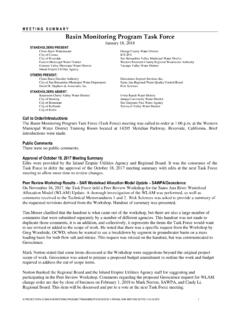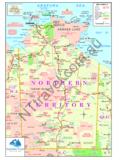Transcription of A JAR TEST STUDY ON THE USE OF ALUM FOR TURBIDITY …
1 A JAR TEST STUDY ON THE USE OF alum FOR TURBIDITY AND nutrient removal IN canyon lake , CA FINAL REPORT Submitted to MWH Americas, Inc. Arcadia, CA. for Elsinore Valley Municipal Water District 31315 Chaney St, lake Elsinore, CA 92531. Submitted by James A. Noblet with research assistance by Emmett Campbell and Graciela Cervantes Department of Chemistry and Biochemistry California State University-San Bernardino December 6, 2012. INTRODUCTION. It has been suggested that treatment of excessive TURBIDITY and algal growth in the east bay and main body of canyon lake may be treated with alum (hydrated Aluminum Sulfate, Al2(SO4)3 nH2O, where n=14-18) a coagulating agent traditionally used in water treatment. In treating water with alum , the natural alkalinity of the water may be used as shown in the following reaction: Al2(SO4)3 nH2O + 3Ca(HCO3)2 2Al(OH)3 + 3 CaSO4 + nH2O + 6CO2 (1). It is preferable that the natural alkalinity of the water be used to form the aluminum hydroxide precipitate rather than adding a base such a lime both in terms of cost and the inability to control mixing dynamics in a natural lake setting.
2 The pH of canyon lake (pH= for recently collected east bay samples) is typically above the optimum range for alum treatment ( , ) [1], but it still may be effective in removing TURBIDITY while not adding to the overall Al concentration of the lake water. Previous studies by Dr. Anderson's group at UC- Riverside (UCR) [2, 3] have shown that effective doses of alum up to 40 mg Al/L ( , ~500 mg alum /L) did not increase the residual water concentration of Al. The pH of alum treated waters dropped significantly within the first hour ( to ) but returned to nearly the ambient pH. within 24 hours. The UCR data show that alum doses of up to 10 mg Al/L (or ~125 mg alum /L). have virtually no persistent effect on the pH of the water. The natural alkalinity of the lake is thus a key parameter for determining the allowable dosing of the water with alum . CSUSB recently collected samples from the east bay at canyon lake .
3 Water samples from Station 9 (Road Runner Beach) and Station 10 (Indian Beach) were analyzed for alkalinity and found to have Total Alkalinities 130 mg/L and 150 mg/L as CaCO3, respectively. The corresponding carbonate alkalinities ( , the phenolphthalein alkalinity, or pH= ) were 36 and 42 mg/L as CaCO3 respectively. The total alkalinities were in fair agreement with the values found by UCR in 2007, which was a lake wide average of 170 mg/L. as CaCO3 ( , meq/L). Quantitative application of equation (1) shows that for every 1. mg/L of alum applied, alkalinity decreases by mg/L. Thus our recent alkalinity data suggest that applications of up to 80 mg/L alum should not decrease the water pH to less than at any time during the application. And the UCR data from 2007 suggest that alum doses up to 250. mg/L may have no long term effect on water pH. A survey of environmental engineering textbooks gave typical ranges of 5-50 mg alum /L as being effective for TURBIDITY removal in most waters.
4 2 METHODS and MATERIALS. Sampling Water samples were collected from four stations at canyon lake on August 27, 2012, two locations in the Main Body and two locations in the East Bay. Samples from the main body of the lake (8 L) were collected from below the thermocline ( , in the hypolimnion). Samples from the east bay were taken at approximately 1 meter depth as the lake at these locations was not stratified. Samples were collected at the same CSUSB monitoring stations that have been used for the past 6 years. The main lake body stations were 7 (near the dam) and 8 (middle of main channel). Samples from the east bay (10 L) were collected at monitoring stations 9 and 10, from the middle of the channel adjacent to Road Runner and Indian beaches, respectively. All water samples were collected using a liter vertical beta type van Dorn sampler (with acrylic tube, Wildlife Supply Company). Repeat grab samples were collected at the appropriate depths until the desired volume was obtained.
5 Samples were transferred to pre- cleaned liter clear glass or liter amber glass bottles. Samples were stored on ice in ice chests until returned to the lab, and then were stored in a walk-in refrigerator at 4 C until analyzed. Depth profiles at each station were measured at 1 meter intervals using a Hach Hydrolab DS-5 water quality sonde. Parameters measured included depth, temperature, electrical conductivity, ORP, and TURBIDITY . Dissolved oxygen data were not obtained as the LDO probe on the Hydrolab was not functioning properly. Data from the depth profile at each station were used to determine in the field at what depth to take the samples. Laboratory Analyses Jar Testing Jar tests were performed on the collected samples using L samples, on a six stirrer Phipps and Byrd programmable jar test apparatus (Figure 1). Jar test were performed as follows: The appropriate amount of 10,000 ppm alum stock was added to each sample, and flash mixed at 220 rpm for minutes, then followed by flocculation at 25 rpm for 30 minutes.
6 The samples were then allowed to settle for 2-3 hours until all of the floc had fully settled. Before and after treatment samples were measured for pH, temperature, TURBIDITY , conductivity, dissolved aluminum concentration, total organic carbon (TOC), total nitrogen and total phosphorus. The goal of the testing was to identify the dose of alum required to achieve a TURBIDITY of less than NTU. The tests were performed at doses of 0 (control, before), 10, 25, 50, 75, and 100 mg/L. alum . Based upon the results of the initial testing, two additional alum concentrations were tested, 125 and 150 mg/L. 3 Figure 1. Phipps and Byrd jar testing apparatus used in this STUDY , at the beginning (top) and at the end of the test procedure after settling of the flocs (bottom). 4 Water Quality Analyses In the laboratory all water quality parameters were measured using methods and protocols as described in standard EPA methods or in Standard Methods for the Examination of Water and Wastewater, 21st edition [4].
7 The temperature, pH and conductivity were measured using a WTW 350i multiparameter field probe. TURBIDITY was measured with a HF Scientific MicroPTW portable turbidimeter. TOC was measured on a Teledyne Tekmar Apollo 9000. combustion TOC analyzer. The total nitrogen (TN) and total phosphorus (TP) were measured on a LACHAT Quickchem 8500 Flow Injection Analysis (FIA) system. Samples were processed using the LACHAT method of persulfate digestion followed by simultaneous TN/TP analysis. The dissolved aluminum concentrations before and after treatment were measured using a Perkin Elmer AAnalyst 600 graphite furnace atomic absorption spectrophotometer, using the EPA. Method protocol [5]. Because of the critical nature of the dissolved aluminum concentrations, blank samples ( , deioniozed water) were subjected to the entire jar testing procedure to ensure that there was no aluminum contamination introduced by either laboratory cleaning and handling procedures or the testing apparatus.
8 None of the blank samples analyzed showed detectable levels of aluminum. RESULTS and DISCUSSION. Field Data The results of the parameters measured in the field are shown in Tables 1-4. The results show that station 7 in the deepest part of the lake near the dam was well-stratified, as usual for that the time of year. Station 8 also in the main channel of the lake was not really stratified with a thermocline appearing at approximately meters above the bottom. Samples were collected at meters and at meters for stations 7 and 8, respectively. Plots of the temperature depth profiles for stations 7 and 8 are shown in Figures 2 and 3. Samples were collected at stations 9. and 10 at approximately 1 meter below the surface. Laboratory Water Quality Data The results of the laboratory water quality analyses are shown in Tables 5-9. For the hypolimnion samples from stations 7 and 8, a dose of 25-50 ppm alum is sufficient to achieve a TURBIDITY of NTU.
9 However, doses of 100 ppm are required to achieve the lowest dissolved Al concentrations, and maximum phosphorus removal . For the east bay water samples, it appears that a dose of 100 ppm alum is required to achieve both TURBIDITY reduction and the lowest dissolved Al concentrations, and maximum phosphorus removal . It is noteworthy that the pH of the sample from station 10 (farthest into the east bay) dropped almost two pH units with a 100 ppm alum dose. However, pH and TURBIDITY measurements taken after 24 hrs showed that pH had gone back up by pH units while TURBIDITY dropped slightly. These initial results show that alum is very effective in reducing the TURBIDITY and phosphorus, and to lesser extent nitrogen content of the waters from throughout the lake , but the 5 residual aluminum concentrations exceed the EPA chronic ambient water quality criterion for protection of aquatic biota, which is 87 g/L for chronic toxicity (the acute toxicity criterion is 750 g/L) [6].
10 In response to the initial results showing dissolved Al concentrations above the chronic criterion, two additional concentrations of alum were evaluated, 125 and 150 mg/L alum . The results of the higher concentrations showed that an alum dose of 150 mg/L was able to reduce the residual dissolved Al concentrations significantly to a range of 89-106 g/L. This is only slightly above the chronic criterion and thus these residual concentrations may be acceptable. The EPA website showing the current ambient water quality criteria for protection of aquatic life has three footnotes associated with the water quality criteria for Al [6]: 1. The value of 87 g/l is based on a toxicity test with the striped bass in water with pH = and hardness <10 mg/L. Data in "Aluminum Water-Effect Ratio for the 3M Plant Effluent Discharge, Middleway, West Virginia" (May 1994) indicate that aluminum is substantially less toxic at higher pH and hardness, but the effects of pH and hardness are not well quantified at this time.










